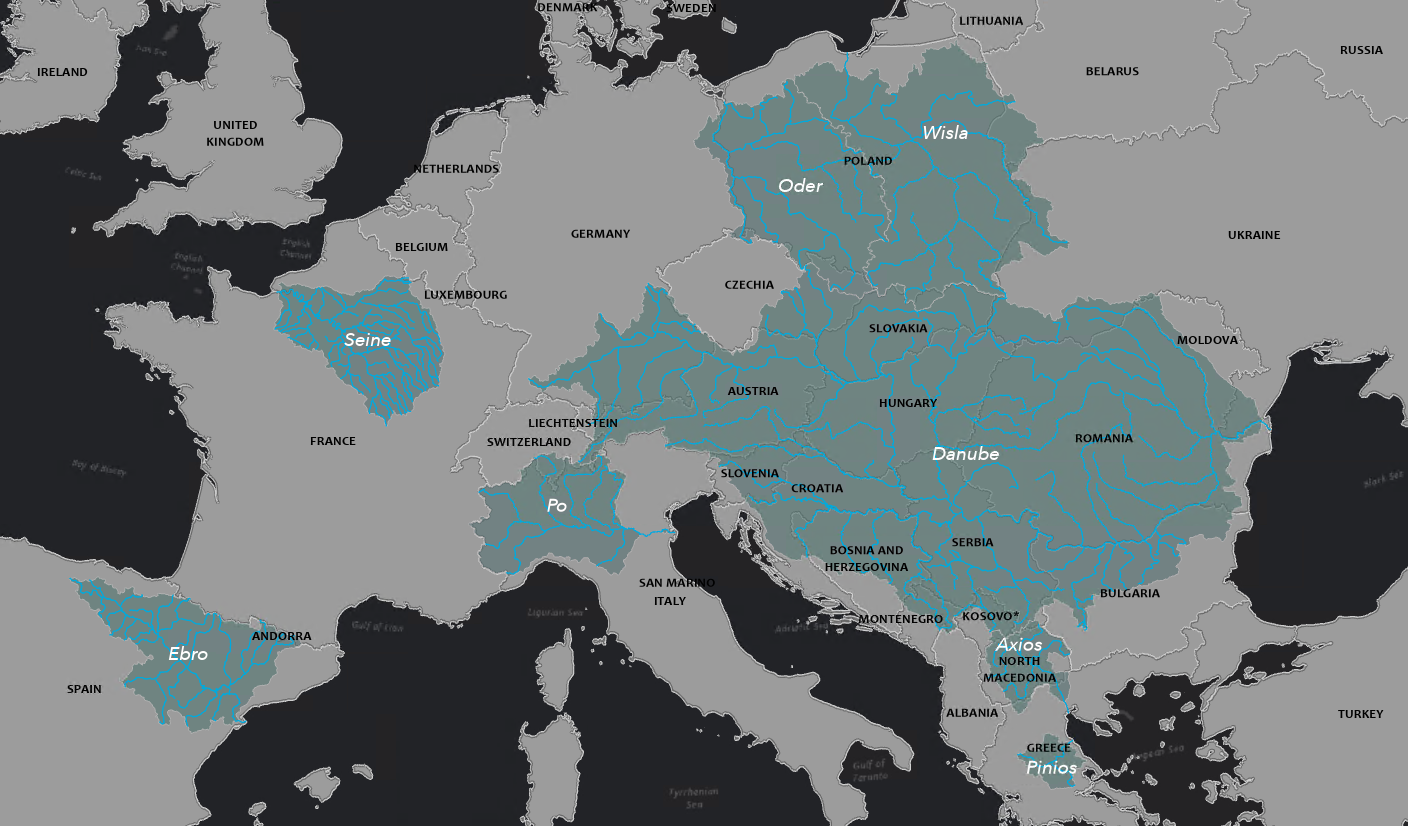Case studies
The scientific evidence of the extent to which agriculture impacts groundwater is herein
examined by focusing on eight major river basins of Europe: Axios, Danube, Ebro, Oder, Pinios,
Po, Seine and Vistula.
Collectively, these basins have a surface area of 1.4 million km2, account for 14% of
the EU territory and host a population of 157 million inhabitants (21% of the total).
The 85 studies considered for the analysis are well distributed across the basins and across
Europe.

Overview
The extent of aquifer nitrification of Europe is unquestionable. The European Environment Agency
estimates that the average nitrate concentration in groundwater aquifers of Europe is 18-19 mg
NO3/l (2000-2017; data from 16 member states).
In response to the Nitrates Directive, all Member States have designated Nitrate Vulnerable
Zones and have established, or are in the process of establishing, comprehensive Programmes of
Measures for the reduction of nitrate pollution of aquifers.
Four lines of evidence of agricultural impacts on groundwater were identified:
- isotopic studies
- aquifer water level decline
- presence of pesticides, herbicides and phosphorus (direct impacts)
- nitrate concentration in groundwater (indirect impact).
Isotopic studies
Isotopic studies provide information on hydrologic pathways, water mixing as well as the source
of nitrates in groundwater.
Nitrate isotopes (15N-NO3 and 18O-NO3) and strontium
isotopic ratios (87Sr/86Sr) have been used as geochemical fingerprints of
nitrogen sources (manure, mineral fertilizers, sewage, and precipitation). The isotopic
composition of water (2H/18O) and tritium measurements help identifying
the proportion of recently infiltrated water versus old groundwater, as well as water residence
time. Finally, carbon (14C-DIC) and sulphate (34S) isotopes have been used
to determine the age of water in the aquifers.
Isotopic studies indicate that the dominant sources of nitrate in aquifers are related to
agricultural activities, particularly mineral fertilization and manure, followed by sewage and
soil organic matter (Table 1).
In addition, most of the studies show that denitrification is a significant nitrate reduction
pathway. The residence time of the water varies from a few to thousands of years, depending on
the aquifer. These studies provide direct evidence linking agricultural activities to aquifer
nitrate contamination across Europe.
| Basin | Country | Source of nitrates | Transit time | Residence time | Denitrification | Reference |
|---|---|---|---|---|---|---|
| Danube | Austria | Manure, fertilizers | 5-100 years | Not significant | Wild 2018 | |
| Czechia | Fertilizers | 21 months | 22 years | Buzek 1998 | ||
| Czechia | Fertilizers | 28 days | Buzek 2006 | |||
| Slovenia | Fertilizers, sewage, manure | Significant | Ogrinc 2019 | |||
| Serbia | Soil organic matter, sewage, manure | Significant | Miljevic 2012 | |||
| Ebro | Spain | Fertilizers | Merchan 2014 | |||
| Oder | Poland | Manure, fertilizers, sewage | Significant | Dragon 2016 | ||
| Poland | Upper aquifer - recent water | Deep 1000 years - circulation due to pumping | Dragon-Gorski 2015 | |||
| Po | Italy | Fertilizers, manure | Significant | Bartoli 2012 | ||
| Italy | Fertilizers, manure, sewage | Significant | Lasagna 2019 | |||
| Italy | Fertilizers, manure, sewage | Significant | Martinelli 2018 | |||
| Italy | Fertilizers | 251-11946 years | Pilla 2005 | |||
| Italy | Mean transit time 2-5 years | Recent infiltration | Rapti 2009 | |||
| Italy | Mixing of Oglio river with aquifer due to irrigation | Rotiroti 2019 | ||||
| Italy | Mineral fertilizers, manure, sewage | Sacchi 2013 | ||||
| Seine | France | Fertilizers | Significant | Floury 2019 | ||
| France | Significant | Garnier 2014s | ||||
| France | Fertilizers | Significant | Sebilo 2003 | |||
| Vistula | Poland | Fertilizers, sewage | Czekaj 2016 |
Aquifer water level decline
Water extraction for irrigation and domestic water supply at rates higher than the aquifer
recharge causes continuous drop of the water table and depletes water resources (aquifer water
level decline).
One of the worst situation was reported in the Pinios basin, where aquifer water level in some
areas has dropped by hundreds of meters.
In areas close to the sea, declines of the water level can cause sea water intrusion. This has
been observed in the deltas of Po and Pinios rivers, as well as in many coastal areas of the
Mediterranean Sea, and is primarily caused by irrigation demand.
Large water extraction for irrigation in Murcia, Almeria and the Alto Guadalentin caused
significant drop of aquifers water level, triggering land subsidence.
Small water level declines due to overextraction have been observed also in Austria, Hungary,
Serbia, Romania and Italy. Such small water table declines can affect spring flow and impact
sensitive ecosystems that depend on them, as in the case of the Po river basin in Italy.
Contamination by pesticides, herbicides and phosphorus
Studies on aquifers contamination by pesticides and herbicides in Axios, Ebro and Po Basins
reported chemicals presence in groundwater.
In the Axios basin, contamination by pesticides (Atrazine and Prometryne) and herbicides
(Alachlor, Propanil, Arbofuran and Paraoxon-methyl) was detected.
In the Ebro basin, Tributylphosphate (pesticide additive), Atrazine and Desethyl atrazine, DEA,
Simazine, and DES were reported.
In the Po basin, a study conducted on five herbicides detected presence of Terbuthylazine (TBA)
and its metabolite Desethylterbuthylazine (DET), likely originating from cropland. Perchlorate
and its by-products (Chlorate and Chlorite), which are present in many fertilizers, were found
in the shallow unconfined aquifer of Ferrara province, in the Po delta groundwater, indicating
agricultural contamination.
Finally, ten studies reported phosphate, which is related primarily to agricultural activities
(over-fertilization), in aquifers of Axios, Pinios, Oder and Vistula basins. Phosphate
concentrations in Poland aquifers were very high, and have been attributed to excess
fertilization.
Nitrate concentration in groundwater
The majority of scientific literature investigated nitrate concentration in groundwater.
Notwithstanding the large spatial and temporal variability of data, 68% of the studies reported
maximum nitrate concentrations measured in aquifers exceeding drinking water standard limits (50
mg NO3/l of nitrate). The presence of nitrate in groundwater is an indirect impact of
diffuse pollution from agricultural land, as confirmed by isotope studies.
Conclusions
The protection of groundwater resources is pivotal in Europe, and several European Directives aim at their protection and restoration, such us the Water Framework Directive (WFD), The Nitrates Directive and the Groundwater Directive. The scientific literature gathered in the eight selected basins showed that:
- Methods for designation of Nitrate Vulnerable Zones should be improved to ensure effective identification of vulnerable areas;
- established Programmes of Measures for improving the water quality of aquifers too often lack definition of measurable actions to ensure gradual improvement. These actions should consider the hydrologic and geochemical response of impacted aquifers. In particular, aquifer residence time is often ignored, but this affect the time horizon required for restoration;
- in response to EU Directives, Member State report a wealth of monitored groundwater data, including both water quality and quantity. In general, scientific literature has not yet taken full advantage of these information sources. Conversely, monitored data are often documented in grey literature (e.g. national conference proceedings published in local languages), making it hard to retrieve and re-use data and hampering assessment of anthropogenic impacts on groundwater resources.

Fact sheets
References
Acknowledgement
The content of this web page is based on the scientific review prepared by Prof. Nikolaos Nikolaidis, Technical University of Crete, Greece
